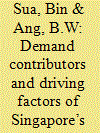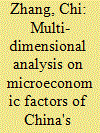|
|
|
Sort Order |
|
|
|
Items / Page
|
|
|
|
|
|
|
| Srl | Item |
| 1 |
ID:
175255


|
|
|
|
|
| Summary/Abstract |
Singapore is an island city state. It lacks conventional energy resources and is alternative energy disadvantaged. Yet its aggregate carbon intensity, given by the ratio of carbon emissions to GDP, dropped by 30% from 2005 to 2014. Currently it has a relatively low carbon intensity. Using I–O analysis, we study Singapore’s aggregate carbon intensity and the factors contributing to its changes at different levels, i.e. final demand, sector, and transmission levels. It is found that domestic exports accounted for nearly two-thirds of Singapore’s aggregate carbon intensity, followed by private consumption and investment. At the sectoral level, the top three contributors were the petroleum, petrochemical, and land transport sectors. Improvements in emission intensity and final demand structure were major factors contributing to reductions in carbon intensity. Our study contributes to the literature in two aspects. Methodologically, it deals with embodied emission intensity and analyzes its changes from the demand perspective. This differs from most studies in the literature from the production perspective. Empirically, the findings and policy implications are unique as they are applicable to a major city. With urbanization taking place in many developing countries, cites’ role in emissions and environmental sustainability are growing in importance but not many in-depth analyses similar to our study have been reported.
|
|
|
|
|
|
|
|
|
|
|
|
|
|
|
|
| 2 |
ID:
127228


|
|
|
|
|
| Publication |
2014.
|
| Summary/Abstract |
This study aims to examine the energy efficiency of the manufacturing industry of Korea by using the extended Divisia index decomposition of Choi and Ang (2012). First, we applied the Sato-Vartia index decomposition to the energy intensity of the manufacturing industry in Korea. Second, we attributed the growth rate of aggregate energy intensity to 10 sub-manufacturing industries through two channels: real energy intensity and structural change. The result of the decomposition illustrates that the aggregate energy intensity index decreased in the period 1981-2010. The index decomposition analysis demonstrates that real energy intensity decreased by 85.85%, whereas structural change increased energy intensity by 69.37% over the same period of time. The negative effect of structural change is partly a result of the increasing portion of energy intensive industry in manufacturing. The result reflects that industrial structure in Korea can be an important aspect for improving energy efficiency.
|
|
|
|
|
|
|
|
|
|
|
|
|
|
|
|
| 3 |
ID:
177157


|
|
|
|
|
| Summary/Abstract |
Reducing energy intensity is the key point to solve the contradiction among economic development, energy constraints and environmental pressure in China. Considering microeconomic factors, this paper extends decomposition and attribution models, and analyses the drivers of China's industrial aggregate energy intensity (AEI) at the regional/sectoral level. The results show that AEI decreased by 49% during 2000–2017. At the regional level, most provinces presented negative contribution on regional energy intensity effect. The AEI decline was attributed to the drop of greatest negative effect of R&D efficiency in Liaoning. The increase in investment intensity and R&D intensity lead to an increase in AEI, largely owning to Shandong and Liaoning, respectively. At the sectoral level, the AEI decline can be mainly explained by the inhibition effect of energy intensity and R&D efficiency. However, this negative contribution was greatly offset by the R&D intensity effect. The investment intensity showed a positive impact in AEI increase, and smelting and pressing of ferrous metals sector was the main contributor. Regional and sectoral investment structure effect shifted from increasing to decreasing AEI over the study period. Based on the results, targeted policy recommendations are proposed to further decrease the China's industrial AEI in the 14th FYP period.
|
|
|
|
|
|
|
|
|
|
|
|
|
|
|
|
| 4 |
ID:
166530


|
|
|
|
|
| Summary/Abstract |
Index Decomposition Analysis (IDA) has been used to analyze driving forces of aggregate carbon intensity (ACI). However, previous studies mostly explained changes in ACI from either sectoral or regional perspective, but rarely looked into driving forces of ACI from both sectoral and regional perspectives under a unified and consistent framework. To fill the research gap, this study proposed a multi-region multi-sector decomposition and attribution approach to analyze driving forces of ACI from both sectoral and regional perspectives. The empirical results in China show that the ACI declined by 33% from 2000 to 2015. From the sectoral perspective, the decline can be mainly attributed to the significant energy efficiency improvement in six high energy-intensive industries. However, the rapid growth in electricity consumption, especially in chemicals and iron and steel, and the expansion of iron and steel industry during 2000–2005 greatly offset the negative effect from energy efficiency. From the regional perspective, the ACI decline can be primarily due to an extensive improvement in energy efficiency in most regions. On the contrary, the increasing dependency on coal, particularly in Shandong, Inner Mongolia, and Guangdong, and the increased share of carbon-intensive industries in some provinces such as Guangxi and Sichuan, markedly increased ACI. Based on the results, the effectiveness of underlying sectoral and regional level policies and measures implemented for ACI reduction in China were evaluated.
|
|
|
|
|
|
|
|
|
|
|
|
|
|
|
|
|
|
|
|
|